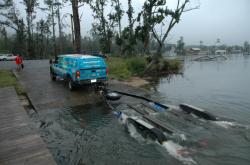 THUNDER BAY – Outdoors Now – Veteran Yamaha Pro Mark Davis has always liked the phrase “hiding in plain sight,” because that’s how he looks at main lake points when he’s searching for summer bass. Of all the places the fish can hide during the warm weather months, points are among the most reliable places to find them.
THUNDER BAY – Outdoors Now – Veteran Yamaha Pro Mark Davis has always liked the phrase “hiding in plain sight,” because that’s how he looks at main lake points when he’s searching for summer bass. Of all the places the fish can hide during the warm weather months, points are among the most reliable places to find them.
“I nearly always start my summer fishing days on points, particularly those that provide close access to deep water,” explains the 1995 Bassmaster Classic® winner and three-time B.A.S.S.® Angler of the Year. “In addition to depth, I look for cover like stumps, rocks, or logs on the point itself that will help attract baitfish; and finally, I prefer to fish a point when it has a breeze or light wind blowing in on it, which helps make that forage more active.
“When I find a point with all three of these elements present, I feel like I’m close to bass and just have to work the water carefully to pinpoint them.”
The Yamaha Pro perfected this warm weather fishing philosophy during years spent as a fulltime guide on Lake Ouachita in Arkansas, and continued it through- out his successful professional tournament career. Because the majority of lakes and reservoirs do have natural points along their shorelines, Davis admitshe is often surprised at how little time many anglers actually spend fishing them.
“Bass everywhere relate to depth changes,” he explains, “perhaps because the deeper water offers them a refuge as well as providing more comfortable temperatures during the hot summer. Even at other times of the year, bass can often be found close to deeper water, and many times points will offer that change.”
Deep water alone, however, may not be enough to keep bass on a point. Summer bass stay close to a food source like shad or crawfish, which is why cover on top of the point is important. That’s why Davis also looks for logs and laydowns, rocks, stumps, or small patches or vegetation, because these will attract and keep the forage nearby.
“If I can’t see the cover visibly, I’ll idle slowly back and forth over the point and study my electronics,” he notes. “The best thing is to actually see shad or small sunfish swimming in front of the boat, but just seeing the cover will be enough to make me start casting.
“I’ll normally start with a deep running crankbait that dives to about 15 or 18 feet, since it will bump into cover, too. Most of the time, this is about as deep as I want to fish, although if the water is clear, I may have to fish as deep as 20 or 25 feet.”
This is one reason the Yamaha Pro also likes wind when he’s fishing in the summer. The water movement, even a light but steady breeze, actually starts a small chain reaction. Plankton get washed against the point’s upwind side and quickly brings in baitfish that begin feeding. Their increased activity stimulates the bass to move in and start feeding, as well.
“We can’t control the wind,” laments Davis, “but I always pay attention when it starts, or even changes direction. It does not have to be a strong wind, either. A good breeze that simply ripples the surface is often enough to make the baitfish start moving and bring in the bass.”
While he’s inclined to start with deep-running crankbaits, Davis also likes to fish large eight and ten-inch plastic works, Carolina rig or Texas-style.
When he’s using a crankbait in these conditions, Davis actually prefers to cast with the wind, rather than into it, a presentation that differs from the one most anglers use. The Yamaha Pro believes basswill be facing into the current or waves to see the forage, but instead of having his crankbait swim into them, he wants it running away from them so he might draw reaction strikes as well as feeding strikes.
He also likes to fish large eight and 10-inch plastic worms, either on a Carolina rig or Texas- style. For this technique, he often moves to the shallow part of the point and casts toward deeper water so he can crawl his lure up the slope. In very windy conditions, it’s much easier to feel and stay in contact with the worm this way.
“I’ll move around and fish the point from different angles, too, depending on the depth, the cover, and the wind until I find the best presentation,” concludes the Yamaha angler. “Whenever Ihave all three of these conditions present, you can bet I’ll stay there awhile, too.
“It’s almost a guarantee the bass are there some- where, hiding in plain sight.”
Article is courtesy of The Fishing Wire.

